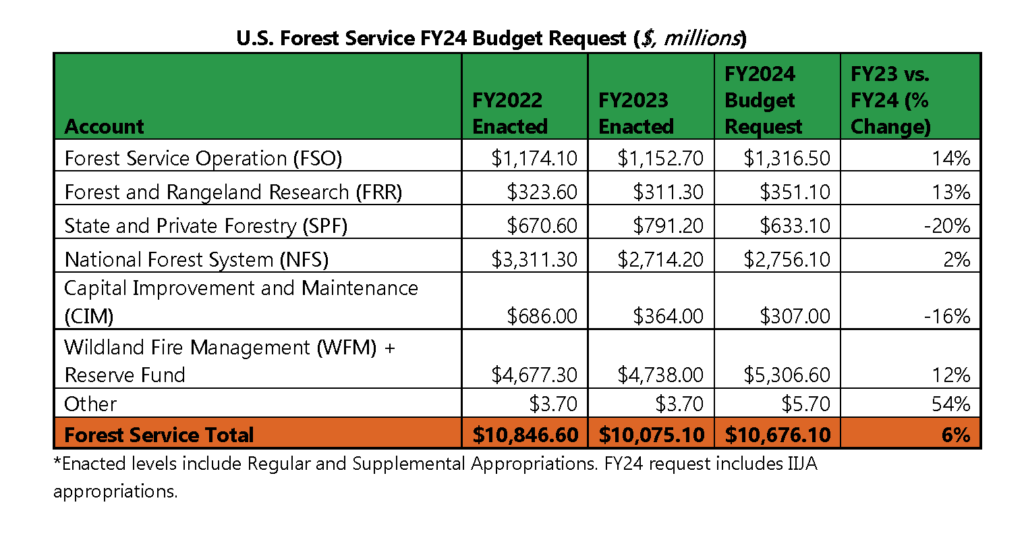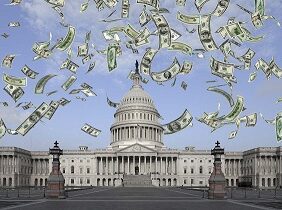On March 22, 2023, the Senate Appropriations Committee, Interior, Environment and Related Agencies subcommittee held a hearing reviewing the U.S. Forest Service’s FY24 budget request. The House Appropriations Committee, Interior, Environment and Related Agencies subcommittee held a similar hearing the next day. U.S. Forest Service Chief Randy Moore testified at both hearings on the agency’s FY24 budget.
The Forest Service (USFS) budget request for FY24 is currently $9.7 billion, with an additional $5.5 billion in appropriations from the Infrastructure, Investment, and Jobs Act (IIJA) for FY24. Combined with money from the IIJA, this request represents an increase of $601 million compared with FY23 enacted levels.
The budget request seeks $2.97 billion to fund Wildland Fire Management (WFM), in addition to the $36 million appropriated through IIJA. This would be a combined $479 million increase compared with FY23 WFM appropriations.

During the Senate hearing, Committee Chair Merkley (D-OR) asked USFS Chief Moore about the Forest Service’s past reliance on using non-fire dollars to fight fires when fire costs have exceeded previous estimates, a practice known as fire borrowing. For decades, this practice of fire borrowing drained agency budgets and compromised other important outdoor, recreational, and forest management programs, including those that were meant for wildfire prevention and risk mitigation.
The Wildfire Suppression Operations Reserve Fund, also referred to as the wildfire funding fix, was established in the FY18 Consolidated Appropriations Bill to prevent USFS from using non-fire dollars toward fire suppression when wildfire funding ran out. The Reserve Fund serves as a resource for USFS and Department of the Interior (DOI) to access if appropriations through the agencies’ WFM accounts are depleted. The Reserve Fund was appropriated $2.25 billion in FY20 and can be increased by $100 million every fiscal year until FY27. When asked by Chairman Merkley (D-OR) how Congress could fix the fix, Chief Moore responded that if Congress let the wildfire funding fix legislation expire in FY27, USFS would return to fire borrowing because fire suppression costs are expected to go up to and exceed $4 billion between now and FY27. Sen. Merkley said that Congress is determined to prevent fire borrowing and will keep the window open for an emergency supplemental of another $450 million this year.
However, appropriating more money alone is not necessarily fixing the fix. The fix serves as a Reserve Fund for USFS to tap into to prevent fire borrowing, but it does not address the perverse incentive to fight fires at all costs because funds are available. And as the funding fix was introduced in part to bypass procedural and budgetary caps on discretionary spending under the Budget Control Act of 2011 (BCA), lawmakers should reassess the budgetary structure of the Reserve Fund now that the BCA has expired. Moreover, Congress needs to build in more transparency and accountability for accessing the Reserve Fund. Any transfers from the Reserve Fund should be closely monitored, and emergency supplemental appropriations must be tracked to better understand the funding fix’s effect on federal suppression spending.
Timber sales were also raised at the hearing. In her opening remarks, ranking member Lisa Murkowski (R-AK) spoke against the administration’s decision in January to reinstate the 2001 Roadless Rule in the Tongass National Forest. The Roadless Rule, implemented in 2001, prohibited road construction, reconstruction, and timber harvesting on 58.5 million acres of national forests across the country, including 9.2 million acres in the Tongass National Forest – the nation’s largest national forest. These protections were removed for the Tongass National Forest in 2020 and reinstated earlier this year.
The Tongass timber program was a money losing endeavor for taxpayers. Between 1980 and 2020, USFS lost approximately $1.7 billion, $44 million per year on average, from timber sales. Reinstating the Roadless Rule in the Tongass National Forest was a win for taxpayers. Not only does the Roadless Rule prevent the high costs of additional logging and roadbuilding, but it also protects our largest national forest and the many economic and climate benefits it provides.
Other policymakers also raised concerns about timber sales in their districts, including Rep. Kilmer (D-WA), who called on USFS to “prioritize increasing active forest management for a healthier ecosystem and for sustainable timber outputs.” In the hearing, Chief Moore emphasized the agency’s commitment to timber markets, highlighting new and spending on programs like wood innovation grants.
However, the focus on timber and other forest products can potentially be problematic, as timber sales could work at cross purpose with other forest management and wildfire mitigation efforts. While timber and other forest products harvest is often a part of hazardous fuels reduction, where harvest can take place is often determined by road access, commercial viability, and other local conditions that may not necessarily align with wildfire spatial patterns and might even undermine overall forest health.











Get Social